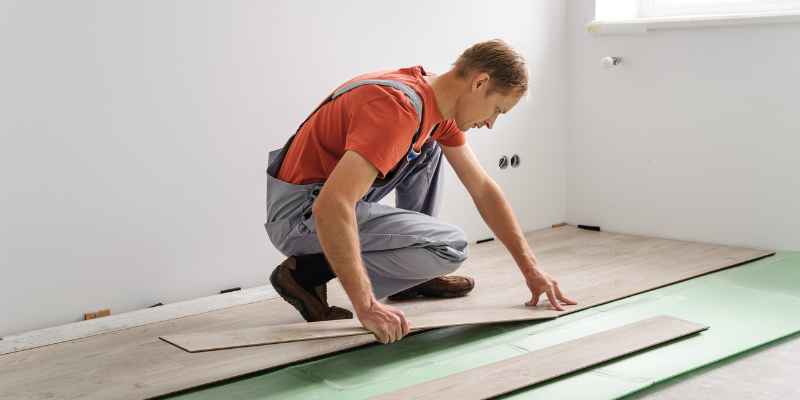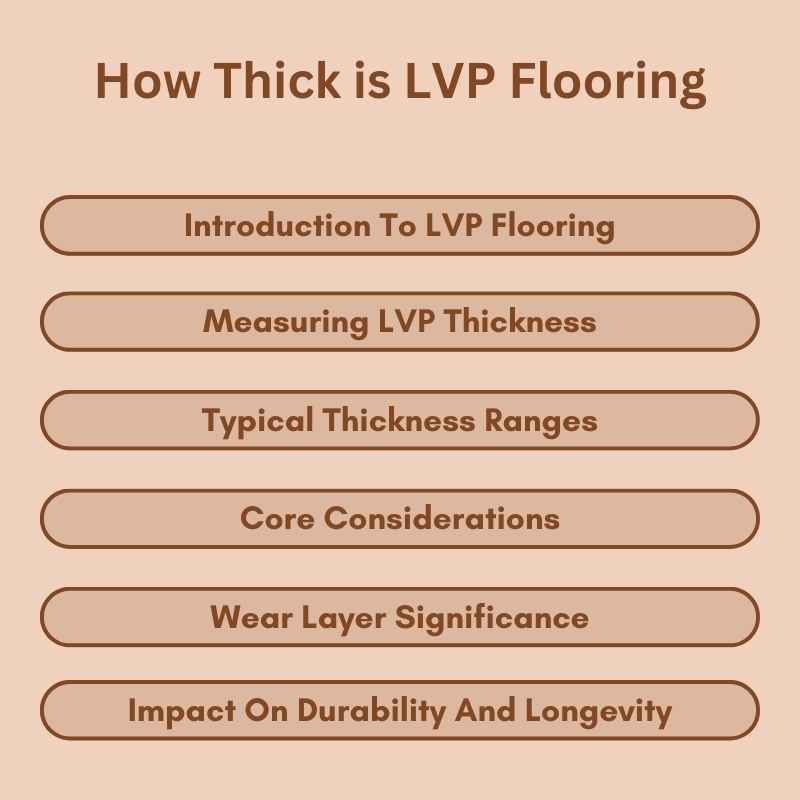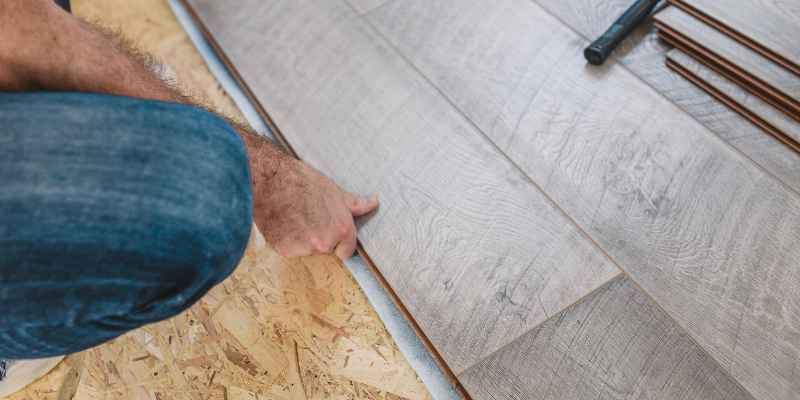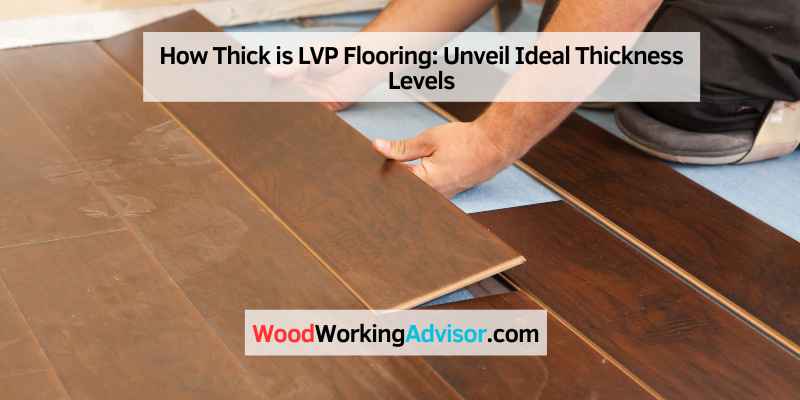LVP flooring, also known as luxury vinyl plank flooring, typically comes in thicknesses ranging from 4mm to 8mm. The thickness of LVP flooring is an important consideration as it can affect its durability and performance.
It is recommended to choose a thickness that suits your specific needs and the level of foot traffic in the area where the flooring will be installed. Additionally, thicker LVP flooring often provides better sound insulation and can better withstand heavy wear and tear.
It is essential to consult with a flooring professional or refer to manufacturer guidelines to determine the best thickness for your specific project.
Introduction To LVP Flooring
LVP flooring thickness typically ranges from 4mm to 8mm, with thicker options offering better durability and noise insulation. Thicker planks also provide a more realistic feel underfoot, making them a popular choice for residential and commercial spaces alike.
LVP, or Luxury Vinyl Plank, is a popular flooring option that has gained immense popularity in recent years. It is known for its durability, versatility, and aesthetic appeal. LVP flooring is designed to mimic the look and feel of real wood or stone, but at a fraction of the cost. It is available in a wide range of styles, colors, and textures, making it suitable for any interior design preference.
Benefits Of LVP
There are several key benefits of LVP flooring that make it a preferred choice among homeowners and designers:
- Durability: LVP is highly durable and can withstand heavy foot traffic, making it suitable for high-traffic areas such as entryways and living rooms.
- Waterproof: Unlike traditional hardwood flooring, LVP is waterproof, making it an ideal choice for kitchens, bathrooms, and basements.
- Easy Maintenance: LVP is easy to clean and maintain. Regular sweeping and occasional mopping are usually sufficient to keep it looking pristine.
- Wide Range of Styles: LVP comes in a variety of styles, including different wood grain patterns and stone textures, allowing homeowners to achieve the desired aesthetic for their space.
- Cost-Effective: LVP is more affordable compared to hardwood or stone flooring options, making it a budget-friendly choice without compromising on style or quality.
LVP Vs. Other Flooring Options
When it comes to comparing LVP with other flooring options, there are several factors to consider:
| LVP | Hardwood | Laminate | Tile | |
|---|---|---|---|---|
| Durability | High | High | Medium | High |
| Waterproof | Yes | No | No | No |
| Maintenance | Easy | Medium | Easy | Easy |
| Aesthetic Options | Wide range | Varies | Varies | Varies |
| Cost | Affordable | Expensive | Affordable | Varies |
As the table shows, LVP offers a compelling combination of durability, waterproofing, easy maintenance, wide aesthetic options, and cost-effectiveness compared to other flooring options.

Measuring LVP Thickness
Luxury Vinyl Plank (LVP) flooring comes in various thicknesses, which can impact its durability and performance. Understanding the thickness of LVP is crucial for making informed decisions when selecting flooring for your space.
Importance Of Accurate Measurement
Measuring the thickness of LVP flooring accurately is essential to ensure compatibility with your subfloor and to determine its overall quality and longevity.
Tools For Measuring Thickness
When measuring LVP thickness, you can use tools such as a digital caliper or a standard tape measure to get precise and reliable measurements.

Typical Thickness Ranges
When it comes to Luxury Vinyl Plank (LVP) flooring, thickness plays a crucial role in determining its durability and performance. Understanding the typical thickness ranges can help you make an informed decision when selecting the right flooring for your space.
Standard Thickness Levels
Standard LVP thickness levels typically range from 4mm to 8mm, with each option offering unique benefits and considerations. Here is a breakdown of the common thickness levels:
| Thickness Level | Benefits |
|---|---|
| 4mm | Cost-effective, suitable for low-traffic areas |
| 5mm | Offers a balance of affordability and durability |
| 6mm | Enhanced durability, ideal for moderate foot traffic |
| 7mm | Increased stability and longevity |
| 8mm | Maximum durability, suitable for high-traffic areas |
Pros And Cons Of Varying Thicknesses
Choosing the right thickness for your LVP flooring involves considering the following pros and cons:
- Thicker planks provide better sound insulation and durability.
- Thinner planks are more affordable and easier to install.
- Thicker planks are less likely to show subfloor imperfections.
- Thinner planks may require additional underlayment for proper installation.
- Thicker planks offer a more substantial feel underfoot.
Core Considerations
When choosing luxury vinyl plank (LVP) flooring, understanding the core layer is crucial. The core layer is a key component of LVP flooring, impacting its durability, stability, and overall performance. Let’s delve into the core considerations to gain insights into the importance of core thickness.
Understanding The Core Layer
The core layer of LVP flooring is typically made of either stone plastic composite (SPC) or wood plastic composite (WPC). This layer provides stability, resilience, and structural integrity to the flooring. The core layer’s construction plays a pivotal role in determining the overall quality and performance of the LVP flooring.
Impact Of Core Thickness On Performance
The thickness of the core layer directly influences the durability and stability of LVP flooring. A thicker core layer enhances the flooring’s resistance to impacts, indentation, and moisture. It also contributes to sound absorption and thermal insulation, making the flooring more comfortable and quieter underfoot.
Wear Layer Significance
Vinyl plank (LVP) flooring has gained immense popularity in recent years due to its durability, water resistance, and aesthetic appeal. One of the key components that determine the performance and longevity of LVP flooring is the wear layer. The wear layer is the topmost, transparent coating of the plank that protects the floor from scratches, stains, and daily wear and tear. Understanding the significance of the wear layer and the optimal thickness is crucial for making informed decisions when selecting LVP flooring for your space.
Role Of The Wear Layer
The wear layer is paramount in shielding the LVP flooring from damage caused by foot traffic, furniture, and other sources of abrasion. It acts as a protective barrier, preserving the visual appeal of the flooring and ensuring its longevity. Additionally, the wear layer contributes to the floor’s resistance to fading, stains, and moisture, making it an essential component for high-traffic areas and spaces prone to spills and accidents.
Optimal Wear Layer Thickness
When considering the wear layer thickness for LVP flooring, it’s essential to strike a balance between durability and cost-effectiveness. The optimal wear layer thickness typically ranges from 6 mil to 20 mil, with higher thickness providing superior protection against wear and tear. In high-traffic commercial areas or homes with pets and children, a thicker wear layer is recommended to maintain the floor’s pristine condition over time. Conversely, for residential spaces with moderate foot traffic, a wear layer on the lower end of the spectrum can offer adequate protection while being more budget-friendly.
Impact On Durability And Longevity
LVP flooring thickness directly impacts its durability and longevity. A thicker plank provides better resistance to wear and tear, making it more durable and long-lasting. Thicker LVP also offers enhanced stability and sound absorption, ensuring a reliable and quiet flooring solution for your space.
When it comes to choosing luxury vinyl plank (LVP) flooring, one of the important factors to consider is the thickness of the planks. The thickness of LVP flooring can have a significant impact on its durability and longevity. In this section, we will discuss the correlation between thickness and durability, along with case studies that demonstrate the impact of thickness on floor lifespan.
Correlation Between Thickness and Durability
The thickness of the wear layer, which is the topmost layer of the LVP flooring, determines its durability. Generally, the thicker the wear layer, the more durable the flooring will be. The wear layer thickness of LVP flooring typically ranges from 4 mil to 30 mil. A 4 mil wear layer is suitable for low-traffic areas such as bedrooms, while a 30 mil wear layer is ideal for high-traffic areas such as commercial spaces.
Apart from the wear layer thickness, the overall thickness of the LVP flooring can also impact its durability. Thicker planks tend to be more durable and have a longer lifespan than thinner planks. However, thicker planks may not be suitable for all installation types, such as floating floors.
Case Studies: Thickness and Floor Lifespan
To illustrate the impact of thickness on floor lifespan, let’s take a look at two case studies:
Case Study 1: A residential property in a high-traffic area installed 8mm LVP flooring with a 20 mil wear layer. After 5 years, the flooring showed signs of wear and tear, with scratches and scuff marks visible in the high-traffic areas. The homeowner decided to replace the flooring with a thicker 12mm LVP flooring with a 30 mil wear layer, which lasted for over 10 years without any signs of wear and tear.
Case Study 2: A commercial property installed 6mm LVP flooring with a 12 mil wear layer. After 2 years, the flooring showed significant signs of wear and tear, with the wear layer completely worn off in some areas. The property owner decided to replace the flooring with a thicker 8mm LVP flooring with a 20 mil wear layer, which lasted for over 5 years without any signs of wear and tear.
In conclusion, the thickness of LVP flooring can have a significant impact on its durability and longevity. It is important to choose the appropriate thickness and wear layer based on the installation type and traffic levels to ensure the flooring lasts for a long time.
Choosing The Right Thickness
When it comes to luxury vinyl plank (LVP) flooring, choosing the right thickness is crucial for both residential and commercial spaces. The thickness of LVP flooring can impact its durability, comfort, and overall performance. Understanding the factors to consider and the guidelines for residential versus commercial use can help you make an informed decision when selecting the thickness of your LVP flooring.
Factors To Consider
When selecting the thickness of LVP flooring, there are several factors to consider:
- Traffic: For high-traffic areas, thicker LVP flooring is recommended to withstand heavy use and maintain its integrity over time.
- Subfloor Condition: Uneven subfloors may require thicker LVP to provide a smooth surface and minimize imperfections.
- Acoustic Properties: Thicker LVP can offer better sound insulation, making it ideal for multi-level residential buildings or commercial spaces.
- Underfloor Heating: If you plan to install LVP over underfloor heating, the thickness can impact heat transfer and overall efficiency.
Guidelines For Residential Vs. Commercial Use
When it comes to residential and commercial applications, the guidelines for LVP thickness differ:
| Application | Recommended Thickness |
|---|---|
| Residential | 4mm to 8mm |
| Commercial | 5mm to 8mm |
Installation And Thickness
When it comes to LVP flooring, the thickness plays a crucial role in the installation process and overall performance. Understanding the installation and thickness considerations is essential for ensuring a successful and durable flooring solution.
Preparation For Different Thicknesses
Before starting the installation process, it’s important to consider the specific thickness of the LVP flooring. Different thicknesses may require varying levels of subfloor preparation to ensure a smooth and stable installation.
- Thinner LVP flooring (4mm or less) may necessitate a more meticulous subfloor leveling to prevent imperfections from telegraphing through the surface.
- Thicker LVP flooring (5mm or more) may offer better sound insulation and durability, but it might require adjustments to door clearances and transitions to adjacent flooring surfaces.
Installation Tips For Optimal Performance
Optimizing the installation process for LVP flooring involves several key considerations to ensure long-term performance and aesthetic appeal.
- Acclimatization: Allow the flooring to acclimate to the room’s temperature and humidity levels for at least 48 hours before installation.
- Subfloor Preparation: Ensure that the subfloor is clean, dry, and level to prevent any issues with the installation or long-term performance.
- Underlayment: Consider using an appropriate underlayment to provide additional cushioning, sound insulation, and moisture protection.
- Adhesive Application: Use the recommended adhesive and follow the manufacturer’s guidelines for proper application to ensure a secure and lasting bond.
- Expansion Gaps: Leave expansion gaps around the perimeter of the room to accommodate potential expansion and contraction of the flooring material.
Maintenance And Thickness
LVP flooring thickness typically ranges from 4mm to 8mm, with 6-8mm being a common choice for durability. The thicker the plank, the more resilient it is to wear and tear, making it ideal for high-traffic areas.
Cleaning Protocols
Maintaining luxury vinyl plank (LVP) flooring is easy, and it requires minimal effort. Regular sweeping, vacuuming, and damp mopping are enough to keep the floor clean. However, it’s essential to avoid using abrasive cleaners and harsh chemicals as they can damage the floor’s surface. Mild soap and warm water are sufficient to remove stains and spills.
Thickness And Repair Considerations
LVP flooring comes in different thicknesses, ranging from 2mm to 8mm. The thicker the flooring, the more durable it is. Thicker floors also have better sound-dampening properties, making them ideal for high-traffic areas. However, thicker floors can be more challenging to cut during installation, and they may require extra adhesive.
When it comes to repairing LVP flooring, thicker floors are easier to repair than thinner ones. Thicker floors have a thicker wear layer, which provides more protection against scratches and dents. In case of damage, it’s easier to replace a single plank on a thicker floor than on a thinner one.
In conclusion, when choosing LVP flooring, it’s essential to consider the thickness and maintenance requirements. Thicker floors are more durable and easier to repair, but they may require extra effort during installation. Regular cleaning with mild soap and water is enough to keep the floor looking new for years to come.

Frequently Asked Questions
How Thick Should My LVP Flooring Be?
For LVP flooring, aim for 6-8mm thickness for durability and quality installation results.
Is 12 Mil LVP Better Than 22 Mil?
The thickness of LVP is measured in mils, with 12 mil being thinner than 22 mil. However, the better option depends on your specific needs and preferences. Thicker LVP may provide more durability and resistance to wear, while thinner LVP can be more affordable and easier to install.
Consider factors like foot traffic, desired lifespan, and budget when choosing the right thickness for your flooring.
How Thick Is 20 Mil LVP?
20 mil LVP flooring is approximately 0. 02 inches thick.
Is A 5mm Vinyl Plank Too Thin?
A 5mm vinyl plank may be considered too thin for some applications, particularly if the subfloor is uneven or there is heavy foot traffic. It is important to consider the wear layer thickness and overall thickness of the flooring when selecting the best option for your needs.
A thickness of 6-8mm is recommended for optimal durability.
Conclusion
To sum up, LVP flooring comes in a variety of thicknesses ranging from 2mm to 8mm, with the most common options being 4mm and 5mm. The thickness of the wear layer is also an important consideration as it affects the durability and longevity of the flooring.
While thicker flooring may be more durable, it can also be more expensive. It’s important to consider your budget, the traffic in your space, and your personal preferences when choosing the thickness of your LVP flooring. With the right thickness and wear layer, LVP flooring can be a great investment for any home or commercial space.

